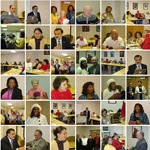Thinking about how we ask questions
- Professors tend to use three types of questions: Horizontal, Non-Referential, and Referential. Our questions should be designed in a strategic way so that we have a goal of what we want the student to walk away with. Too many professors ask questions very haphazardly, and students do not obtain the anticipated results. Additionally, there was some discussion on how questions are processed (cognitively), and how to frame them in a way to get students to use higher-order thinking.
Developing hybrid courses
- There was a couple of discussions on the benefits of hybrid classes versus traditional classes and online classes. This is something I have done at a previous institution, and would love for Winston-Salem State to adopt. I have had some push back on it, but I think students would really enjoy this online/in-person format. The presenters said they suggest listing the class as traditional, but a significant portion of the class will take place online. While the session was really informative, I did not get some of my questions answered by the presenters. For example, how do you market a hybrid class to your department or dean, when there is such a big push for student contact hours?
Effective and efficient ways to use discussion boards and blogs.
- There were a number of presenters who spoke about using discussion boards and blogs in their classes. Much of the focus was on actual usage, but there were a few people who had good and fresh suggestions that made sense. One suggestion was to change the Required Posting format so that students have to post their responses prior to reading any other posts. This prevents students from *paraphrasing* another student’s response. Another suggestion was to do Fishbowl discussions online. Students are selected and assigned to a discussion, while other students don’t respond but read and reflect on the discussion that took place. Finally, the suggestions to post an article (news-related, pop culture, etc.) and have students respond to it on the discussion boards/blogs. While this is not innovative, the way in which the presenters set this up for their students was really cool. Perhaps the key to success is in the selection of material to post.
Using Wikis for Small Groups
- The final piece of information I found helpful was about using Wikis. I already use Wikis in my classes, but they had some of the most elaborate Wikis I have ever seen. They used a template to create small group workspaces. I don’t believe we currently have access to this template, but if we did-- I think it would greatly improve student usage.
I did learn that Winston-Salem State is a bit behind in some of the technological tools that were on display during the conference. However, I also learned that our quality of teaching and presenting is probably better than most of those I came in contact with during the week. Overall, it was a great experience to see and hear some of the latest and most innovative ways to disseminate knowledge to our students. I will say the biggest disappointment of the conference was the organization. Hopefully in the future, more thought will be given to specific tracks for participants, or a re-vamping of how the presentation sessions are designed.
